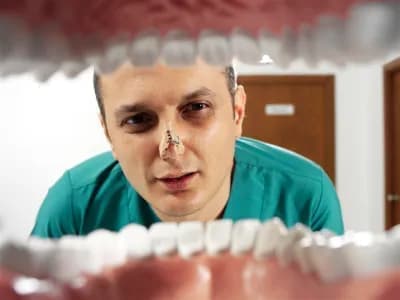Bad breath, known clinically as halitosis, is difficult to measure and diagnose but it is not impossible. Caused by a variety of bacteria producing sulfurous compounds in the mouth and nose, bad breath can easily be underestimated or overestimated with a self-diagnosis due to the subjectivity of its intensity. Many professional bad breath diagnosis methods are available, but a personal bad breath test can also be done to give indications of halitosis levels.
Professional Diagnosis
Because of the subjectivity of a personal bad breath test, a professional bad breath diagnosis is typically the most accurate. The gold standard in diagnosing halitosis is referred to as an organoleptic measurement of the air in the mouth. This test is simply a smelling test administered by a trained expert at a distance of 10 cm from a patient's mouth. The professional then rates the severity of perceived smell on a scale of zero to five to give an indication of the severity of bad breath.

Several other clinical bad breath tests exist to chemically detect the sulfurous emissions of a person's breath. The most common instrument in detecting bad breath is called the halimeter. It can be very effective at detecting bacteria that produce volatile sulfur compounds (VSCs) that are the root cause of bad breath. Halimeters have the drawback of giving false readings due to the temporary effects of certain foods that give off sulfur such as onion and garlic. Some common sulfides, like mercaptan, cannot be detected with this method.
Other sophisticated clinical detection methods include gas chromatography which uses a machine to measure levels of dimethyl sulfide, hydrogen sulfide and methyl mercaptan and produces very accurate graphical results. The BANA test is a swab strip test that tests for enzymes resulting from bad breath bacteria. Another enzyme test checks for beta-galactosidase, an enzyme that, when present in the mouth in large concentrations, correlates to higher rates of bad breath.
No matter what type of test is used, professional diagnosis of bad breath is an excellent way to confirm the causes of the halitosis and determine what level of halitosis actually exists. Many of these tests are offered by dental offices and clinics to help diagnose and manage bad breath in a detailed and accurate manner.
Personal Testing
Although personal testing is not considered to be as reliable or accurate as professional and clinical bad breath tests, a self-diagnosis can provide a reasonably good benchmark for understanding the extent of bad breath and starting a program to manage it. The traditional method of cupping a hand to the mouth and nose and breathing into it simply does not work, because scents on the hand get in the way. Additionally, it is very difficult to smell one's own breath anyway, even without competing odors, because people are typically too acclimatized to their own odors to make an accurate assessment. Some methods, however, give more accurate results for testing bad breath and can be done at home for little or no cost.

One of the most accurate self-testing methods for bad breath is a tongue scrape. Using a plastic spoon or a cotton ball, a person gently scrapes the back of his or her tongue and smells the drying residue left on the scraping instrument. Another similar but less accurate test is to lick the back of a hand and smell it as it dries. The licking method does not give as genuine a result because of other odors that might be present on the hand and would not be present on a cotton swab or plastic spoon. Dental floss might also be used to scrape the back of the tongue or behind molars for an indication of the odors present in the mouth.
One of the best self-test indicators is a confidant test, in which a person asks a relative or close friend to assess a bad breath situation. The benefits of this test include the confidant being able to truly tell to what degree the bad breath is affecting other people and whether treatment regimens are being effective at treating the halitosis.
Many tests, both personal and professional, exist to help determine a bad breath diagnosis. Professional tests can help find the exact bacteria-causing agents for halitosis, and personal tests can be useful in initially assessing bad breath and monitoring treatment progress. Although each test has its strengths and weaknesses, bad breath testing can assist in finding the best treatment and management plans to help eliminate bad breath.
